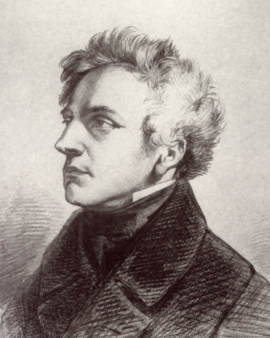Growing up in an artistically ambitious family, Johann Peter Krafft began studying at the Vienna Academy of Fine Arts in the history painting department in 1799 at the age of 19, after having successfully attended a drawing school at a young age. He then continued his education in the art centers of Munich, Strasbourg and Paris. Influenced by his traveling companion Julius Schnorr von Carolsfeld, who was devoted to romantic painting, as well as inspired by the classicist court painter, Krafft turned increasingly to lucrative portrait painting after his return. Under the spell of contemporary classical trends, he created murals with mythological and historical scenes for the wife of Emperor Franz I, subsequently using the fee to finance a stay in Rome.
In the following years, he could look back on an impressive career and a full resume. Among other things, he became a member of the Academy of Fine Arts in 1813 and the Hanau Academy of Drawing two years later. In 1817 he furnished the Vienna Invalidenhaus with large paintings and in 1823 was appointed corrector and professor of history painting at the Academy. Here he was drawn away from antique imitation to a more realistic observation of nature. The Viennese court commissioned him to decorate the audience chamber in the Imperial Chancellery Wing and appointed him director of the Imperial Picture Gallery. As the official palace director, he and his family moved to his workplace in one of the palace wings and carried out both a redesign of the gallery and a restoration of the badly neglected Belvedere Garden. He was also involved in restoration and monument conservation, for example restoring the frescoes in Schönbrunn's Great Gallery and in the Jesuit Church, and preparing expert reports on monument conservation for Karlstein Castle.
Given his extensive activities for the Viennese court, it is surprising that Krafft found time at all to engage in artistic activities. Nevertheless, he had a great influence on Austrian painting, not least through the paintings Der Abschied des Landwehrmannes (1813) and Die Heimkehr des Landwehrmannes (1820), which refer to the Biedermeier era. His oeuvre includes depictions of Emperor Franz I, Emperor Ferdinand II, Emperor Rudolf II, high-ranking members of the military and nobility, as well as portraits of ladies, oriental depictions, contemporary war scenes, modern event paintings, studies of biblical themes and Greek legends, genre paintings and classicist architectural studies. Johann Peter Krafft remained a resident of the Belvedere until his death in 1856, was subsequently buried in a dignified tomb in Vienna's Central Cemetery, and was posthumously honored with the naming of Krafftgasse in Vienna's Leopoldstadt (2nd district).
×





.jpg)
.jpg)
.jpg)
.jpg)
.jpg)
.jpg)
.jpg)
.jpg)
.jpg)
.jpg)
.jpg)
.jpg)
.jpg)
.jpg)
.jpg)
.jpg)
.jpg)
.jpg)
.jpg)
.jpg)
.jpg)
.jpg)
_(ecall)_1809_Su_-_(MeisterDrucke-984183).jpg)
_(ecall)_1809_Su_-_(MeisterDrucke-984183).jpg)
.jpg)
.jpg)
_-_(MeisterDrucke-1034363).jpg)
_-_(MeisterDrucke-1034363).jpg)
.jpg)
.jpg)
.jpg)
.jpg)
.jpg)
.jpg)
.jpg)
.jpg)
.jpg)
.jpg)
.jpg)
.jpg)
.jpg)
.jpg)
_-_(MeisterDrucke-1347161).jpg)
_-_(MeisterDrucke-1347161).jpg)
.jpg)
.jpg)
.jpg)
.jpg)
.jpg)
.jpg)
.jpg)
.jpg)
.jpg)
.jpg)
.jpg)
.jpg)
.jpg)
.jpg)
.jpg)
.jpg)
.jpg)
.jpg)
.jpg)
.jpg)
.jpg)
.jpg)
.jpg)
.jpg)
.jpg)
.jpg)
.jpg)
.jpg)
.jpg)
.jpg)
.jpg)
.jpg)
.jpg)
.jpg)
_-_(MeisterDrucke-1508964).jpg)
_-_(MeisterDrucke-1508964).jpg)
_-_(MeisterDrucke-1349488).jpg)
_-_(MeisterDrucke-1349488).jpg)
.jpg)
.jpg)
.jpg)
.jpg)
.jpg)
.jpg)
.jpg)
.jpg)
.jpg)
.jpg)
.jpg)
.jpg)
_-_(MeisterDrucke-1347077).jpg)
_-_(MeisterDrucke-1347077).jpg)
.jpg)
.jpg)
.jpg)
.jpg)
.jpg)
.jpg)
.jpg)
.jpg)
.jpg)
.jpg)
.jpg)
.jpg)
.jpg)
.jpg)
.jpg)
.jpg)
.jpg)
.jpg)
.jpg)
.jpg)
.jpg)
.jpg)
.jpg)
.jpg)
.jpg)
.jpg)
.jpg)
.jpg)
_(1768-1835)_to_Pres_-_(MeisterDrucke-555846).jpg)
_(1768-1835)_to_Pres_-_(MeisterDrucke-555846).jpg)
.jpg)
.jpg)
.jpg)
.jpg)
.jpg)
.jpg)
.jpg)
.jpg)
.jpg)
.jpg)
.jpg)
.jpg)
.jpg)
.jpg)
.jpg)
.jpg)
.jpg)
.jpg)
.jpg)
.jpg)
.jpg)
.jpg)
.jpg)
.jpg)
.jpg)
.jpg)
.jpg)
.jpg)
.jpg)
.jpg)
.jpg)
.jpg)
.jpg)
.jpg)
.jpg)
.jpg)
.jpg)
.jpg)
.jpg)
.jpg)
.jpg)
.jpg)
.jpg)
.jpg)
.jpg)
.jpg)
.jpg)
.jpg)
.jpg)
.jpg)
.jpg)
.jpg)
.jpg)
.jpg)
.jpg)
.jpg)
.jpg)
.jpg)
.jpg)
.jpg)
.jpg)
.jpg)
.jpg)
.jpg)
.jpg)
.jpg)
.jpg)
.jpg)
.jpg)
.jpg)
.jpg)
.jpg)
.jpg)
.jpg)






